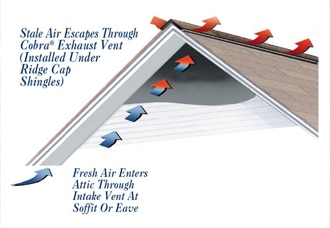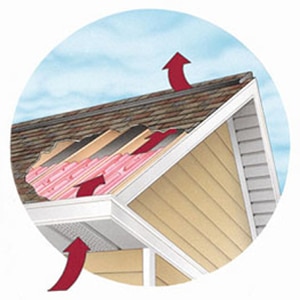Now that the Fall season is here and Winter is approaching, saving on energy costs and preventing weather damage are high priorities for home owners.
 Many homeowners are unaware that a proper roof/attic ventilation system can effectively reduce heating and cooling bills, reduce moisture that can lead to black mold growth, and help prevent roof rot and ice dams in winter – which can extend roof shingle life. A proper attic ventilation system for your home will allow a continual flow of outside air through the attic, protecting the efficiency of the insulation and helping to maintain comfortable temperatures in the living space. The system generally consists of a balance between air intake (at your eaves or soffits) and air exhaust (at or near your roof ridge).
Many homeowners are unaware that a proper roof/attic ventilation system can effectively reduce heating and cooling bills, reduce moisture that can lead to black mold growth, and help prevent roof rot and ice dams in winter – which can extend roof shingle life. A proper attic ventilation system for your home will allow a continual flow of outside air through the attic, protecting the efficiency of the insulation and helping to maintain comfortable temperatures in the living space. The system generally consists of a balance between air intake (at your eaves or soffits) and air exhaust (at or near your roof ridge).
Proper attic ventilation serves two key functions:
- Allows fresh air to enter the attic at the eave or soffit areas of the roof
- Exhausts hot, moist air from the attic by way of the ridge or other exhaust vents. This hot, moist air can cause a whole host of issues.
In cold climates, ventilation helps maintain a “cold” roof system by mixing cool outside air with attic air to allow for less snow melting on the roof, therefore avoiding damaging ice damming. In warm climates, proper attic ventilation helps expel hot air, which can contributes to moisture problems.
Benefits of proper ventilation include:
 Helps reduce damaging moisture. Excessive moisture can build up in the attic, potentially damaging the structure and degrading the roof system. It can also lead to mold.
Helps reduce damaging moisture. Excessive moisture can build up in the attic, potentially damaging the structure and degrading the roof system. It can also lead to mold.- Can help save energy. Heat build-up in that attic comes at a cost—a home’s air conditioning has to work harder to cool down the house, especially the living space below the attic.
- Helps prevent damage to the roof shingles. High attic heat can bake the shingle and cause them to prematurely age. In fact, most major shingle manufacturers strongly recommend proper attic ventilation on asphalt shingle installations.
Unfortunately, most homes in North America are improperly ventilated, which can result in mold, wasted energy, ice dams, premature roof system degradation, rotting decks, peeling paint, and ceiling stains.
The U.S. FHA (Federal Housing Administration) recommends a minimum of at least 1 square foot of attic ventilation (both intake and exhaust) for every 300 square feet of attic space. For example, if your attic is 900 square feet, you need a total of 3 square feet of ventilation. This amount should be divided equally between intake and exhaust ventilation (i.e., 1 1/2 feet of each) to insure proper air flow through the attic
In the winter, various household appliances, bathtubs, showers, and cooking vapors can contribute to excess moisture build-up. Improperly ventilated attics will allow this moisture to collect and cling to the underside of the roof. The moisture will condense and fall, soaking the attic insulation and reducing its efficiency.
The resulting structural damage to your home can include:
- Roof deck warping and rotting of the wood frame
- Mildew growth
- Buckling of shingles and felt
Attics should be properly ventilated to help prevent ice dams in cold winter climates. During the winter, ice and snow on a roof will melt and run down the deck to the cooler eaves. This run-off can re-freeze, creating an ice dam that may force water back up under the shingles and leak into your home — causing hundreds or thousands of dollars of damage to your ceilings and walls. Adequate attic ventilation reduces the amount of initial melting that occurs on your roof, thereby reducing the chance that ice dams will form.
In the summer, improper ventilation can cause attic heat to build in excess of 160°F. This super-heated air eventually penetrates the ceiling insulation into the living area below.
Types of damage that can result include:
- Premature aging of your roofing system (“fried” shingles)
- Warping, cracking, or breaking down of wood framing
- Damage to siding, exterior or interior paint, and wallpaper
A properly ventilated attic can also help reduce the load on your air conditioner by moving the super-heated air out of your attic before it builds up and causes damage.
Without adequate airflow in your attic, you could be looking at higher than necessary energy bills, and premature aging of key systems such as your home’s roof and attic insulation. All American Roofing Company has highly trained and experienced attic ventilation professionals who can help you to evaluate if your home may benefit from improved attic ventilation measures.
CLICK HERE to schedule a FREE Inspection of your home’s attic ventilation system. Or call us with any questions you may have at: 1-877-ROOF-PRO.
